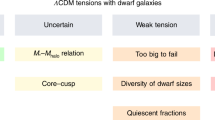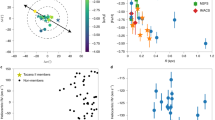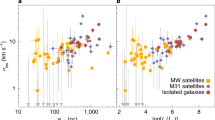Abstract
For almost two decades the properties of ‘dwarf’ galaxies have challenged the cold dark matter (CDM) model of galaxy formation1. Most observed dwarf galaxies consist of a rotating stellar disk2 embedded in a massive dark-matter halo with a near-constant-density core3. Models based on the dominance of CDM, however, invariably form galaxies with dense spheroidal stellar bulges and steep central dark-matter profiles4,5,6, because low-angular-momentum baryons and dark matter sink to the centres of galaxies through accretion and repeated mergers7. Processes that decrease the central density of CDM halos8 have been identified, but have not yet reconciled theory with observations of present-day dwarfs. This failure is potentially catastrophic for the CDM model, possibly requiring a different dark-matter particle candidate9. Here we report hydrodynamical simulations (in a framework10 assuming the presence of CDM and a cosmological constant) in which the inhomogeneous interstellar medium is resolved. Strong outflows from supernovae remove low-angular-momentum gas, which inhibits the formation of bulges and decreases the dark-matter density to less than half of what it would otherwise be within the central kiloparsec. The analogues of dwarf galaxies—bulgeless and with shallow central dark-matter profiles—arise naturally in these simulations.
This is a preview of subscription content, access via your institution
Access options
Subscribe to this journal
Receive 51 print issues and online access
$199.00 per year
only $3.90 per issue
Buy this article
- Purchase on Springer Link
- Instant access to full article PDF
Prices may be subject to local taxes which are calculated during checkout




Similar content being viewed by others
References
Coles, P. The state of the Universe. Nature 433, 248–256 (2005)
Dutton, A. On the origin of exponential galaxy discs. Mon. Not. R. Astron. Soc. 396, 121–140 (2009)
de Blok, W. J. G. et al. High resolution rotation curves and galaxy mass models from THINGS. Astron. J. 136, 2648–2719 (2008)
Governato, F. et al. Forming disc galaxies in ΛCDM simulations. Mon. Not. R. Astron. Soc. 374, 1479–1494 (2007)
Abadi, M. G., Navarro, J. F., Steinmetz, M. & Eke, V. R. Simulations of galaxy formation in a Λ cold dark matter Universe. I. Dynamical and photometric properties of a simulated disk galaxy. Astrophys. J. 591, 499–514 (2003)
Moore, B. et al. Cold collapse and the core catastrophe. Mon. Not. R. Astron. Soc. 310, 1147–1152 (1999)
van den Bosch, F. C., Burkert, A. & Swaters, R. A. The angular momentum content of dwarf galaxies: new challenges for the theory of galaxy formation. Mon. Not. R. Astron. Soc. 326, 1205–1215 (2001)
Mashchenko, S., Wadsley, J. & Couchman, H. M. P. Stellar feedback in dwarf galaxy formation. Science 319, 174–177 (2008)
Primack, J. Cosmology: small scale issues revisited. New J. Phys. 11 (10). 105029 (2009)
Spergel, D. N. et al. First-year Wilkinson Microwave Anisotropy Probe (WMAP) observations: determination of cosmological parameters. Astrophys. J. Suppl. Ser. 148, 175–194 (2003)
Fall, S. M. & Efstathiou, G. Formation and evolution of disc galaxies with haloes. Mon. Not. R. Astron. Soc. 193, 189–206 (1980)
Barnes, J. E. & Hernquist, L. Transformations of galaxies. II. Gasdynamics in merging disk galaxies. Astrophys. J. 471, 115–142 (1996)
Simon, J. D., Bolatto, A. D., Leroy, A., Blitz, L. & Gates, E. L. High-resolution measurements of the halos of four dark matter-dominated galaxies: deviations from a universal density profile. Astrophys. J. 621, 757–776 (2005)
Swaters, R. A., Verheijen, M. A. W., Bershady, M. A. & Andersen, D. R. The kinematics in the core of the low surface brightness galaxy DDO 39. Astrophys. J. 587, L19–L22 (2003)
Maller, A. H. & Dekel, A. Towards a resolution of the galactic spin crisis: mergers, feedback and spin segregation. Mon. Not. R. Astron. Soc. 335, 487–498 (2002)
Binney, J., Gerhard, O. & Silk, J. The dark matter problem in disc galaxies. Mon. Not. R. Astron. Soc. 321, 471–474 (2001)
Martin, C. L. Properties of galactic outflows: measurements of the feedback from star formation. Astrophys. J. 513, 156–160 (1999)
Wilman, R. J. et al. The discovery of a galaxy-wide superwind from a young massive galaxy at redshift z ≈ 3. Nature 436, 227–229 (2005)
Robertson, B. & Kravtsov, A. Molecular hydrogen and global star formation relations in galaxies. Astrophys. J. 680, 1083–1111 (2008)
Ceverino, D. & Klypin, A. The role of stellar feedback in the formation of galaxies. Astrophys. J. 695, 292–309 (2009)
Mo, H. J. & Mao, S. Galaxy formation in pre-processed dark haloes. Mon. Not. R. Astron. Soc. 353, 829–840 (2004)
Mashchenko, S., Couchman, H. M. P. & Wadsley, J. The removal of cusps from galaxy centres by stellar feedback in the early Universe. Nature 442, 539–542 (2006)
Haardt, F. & Madau, P. Radiative transfer in a clumpy Universe. II. The ultraviolet extragalactic background. Astrophys. J. 461, 20–37 (1996)
Lee, J. C. et al. Dwarf galaxy starburst statistics in the Local Volume. Astrophys. J. 692, 1305–1320 (2009)
Walter, F. & Brinks, E. Holes and shells in the interstellar medium of the nearby dwarf galaxy IC 2574. Astron. J. 118, 273–301 (1999)
Jonsson, P. SUNRISE: polychromatic dust radiative transfer in arbitrary geometries. Mon. Not. R. Astron. Soc. 372, 2–20 (2006)
Geha, M., Blanton, M. R., Masjedi, M. & West, A. A. The baryon content of extremely low mass dwarf galaxies. Astrophys. J. 653, 240–254 (2006)
Valenzuela, O. et al. Is there evidence for flat cores in the halos of dwarf galaxies? The case of NGC 3109 and NGC 6822. Astrophys. J. 657, 773–789 (2007)
Brooks, A. et al. The origin and evolution of the mass-metallicity relationship for galaxies: results from cosmological n-body simulations. Astrophys. J. 655, L17–L20 (2007)
Pontzen, A. et al. Damped Lyman α systems in galaxy formation simulations. Mon. Not. R. Astron. Soc. 390, 1349–1371 (2008)
Acknowledgements
We acknowledge discussions with L. Blitz, A. Kravtsov, J. Primack, I. Trujillo and V. Wild. We thank R. Swaters and the THINGS team for sharing some of their data with us. L.M. and C.B. thank the Kavli Institute for Theoretical Physics at the University of California, Santa Barbara, for hospitality during the early stages of this work. F.G. and P.M. thank the computer support people at Nasa Advanced Supercomputing, TERAGRID, ARSC and UW, where the simulations were run.
Author Contributions F.G. provided the scientific leadership, designed the numerical experiments, wrote the paper and led the analysis and interpretation of the simulations. C.B. and A.B. performed part of the analysis. C.B., L.M., A.B., B.W. and P.M. helped with the interpretation and the writing of the manuscript. J.W., T.Q. and G.S. developed GASOLINE, the code used for the simulations. P.J. developed the analysis code SUNRISE. G.R. performed the kinematical analysis of the simulations.
Author information
Authors and Affiliations
Corresponding author
Ethics declarations
Competing interests
The authors declare no competing financial interests.
Supplementary information
Supplementary Information
This file contains Supplementary Methods and Data, Supplementary Tables 1-2, Supplementary Notes, Supplementary References, Supplementary Figures 1-4 with Legends and the Legend for Supplementary Movie 1. (PDF 1154 kb)
Supplementary Movie 1
The movie shows the evolution of the gas density in the region where galaxy DG2 forms, from shortly after the Big Bang to the present time (see Supplementary Information file for full Legend). (MOV 21555 kb)
Rights and permissions
About this article
Cite this article
Governato, F., Brook, C., Mayer, L. et al. Bulgeless dwarf galaxies and dark matter cores from supernova-driven outflows. Nature 463, 203–206 (2010). https://doi.org/10.1038/nature08640
Received:
Accepted:
Issue Date:
DOI: https://doi.org/10.1038/nature08640
This article is cited by
-
Dark matter halo mass functions and density profiles from mass and energy cascade
Scientific Reports (2023)
-
Universal scaling laws and density slopes for dark matter haloes
Scientific Reports (2023)
-
SIMPly add a dark photon
Journal of High Energy Physics (2023)
-
Observational constraints on stellar feedback in dwarf galaxies
Nature Astronomy (2022)
-
Gas dynamics in dwarf galaxies as testbeds for dark matter and galaxy evolution
Nature Astronomy (2022)
Comments
By submitting a comment you agree to abide by our Terms and Community Guidelines. If you find something abusive or that does not comply with our terms or guidelines please flag it as inappropriate.



